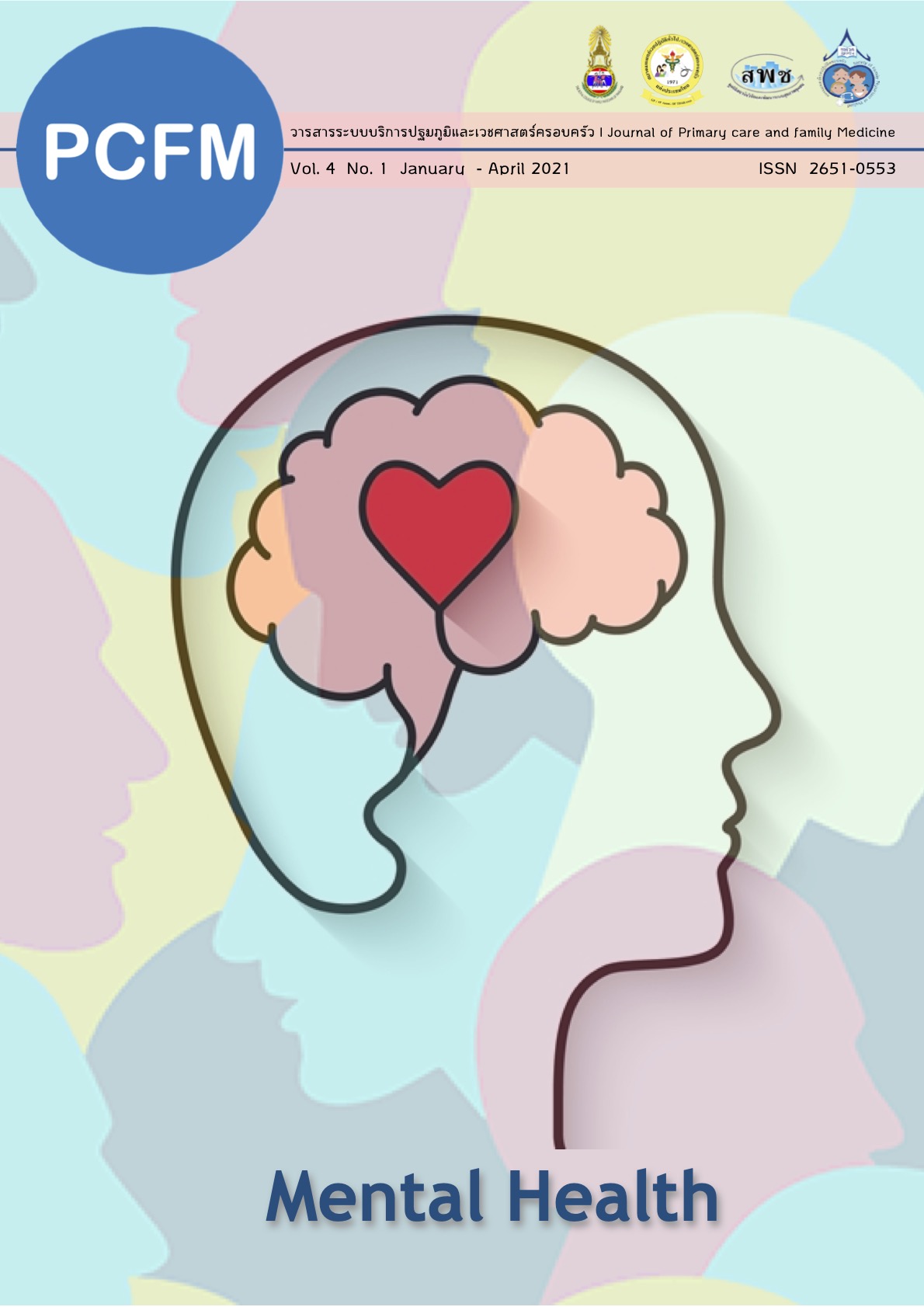บทบาททีมเวชศาสตร์ครอครัวที่มีต่อการดูแลต่อเนื่อง: กรณีศึกษาการจัดการผู้ป่วยโรคหลอดเลือดสมองเฉียบพลัน
Main Article Content
บทคัดย่อ
ชายวัยกลางคนที่อยู่ในช่วงทำงาน มีอาชีพที่รุ่งเรือง เป็นผู้ที่หารายได้หลักให้กับครอบครัว มีความมั่นใจในการดำรงชีวิต ขาดความตระหนักต่อการดูแลสุขภาพของตนเองเพราะคิดว่าตนเองยังแข็งแรง ใช้ชีวิตอยู่ในความเสี่ยงต่อสุขภาพเช่น กินเหล้า สูบบุหรี่ พักผ่อนไม่เพียงพอ เมื่อเกิดการเจ็บป่วยที่รุนแรงจนไม่สามารถช่วยเหลือตัวเองได้ จึงเสมือนการเผชิญข่าวร้ายที่ไม่ได้เตรียมตัว ในระยะแรกจะเกิดภาวะสิ้นหวัง ท้อแท้1 สภาพจิตใจที่สูญเสียความเชื่อมั่นจึงส่งผลต่อการฟื้นตัวของร่างกาย2,3 การออกแบบดูแลผู้ป่วยต่อเนื่องในเชิงรุกของทีมเวชศาสตร์ครอบครัว ขณะตั้งแต่ผู้ป่วยอยู่ในโรงพยาบาลโดยวางแผนร่วมกับครอบครัวก่อนกลับบ้าน ไปจนถึงติดตามเยี่ยมผู้ป่วยที่บ้านด้วยทีมสหวิชาชีพร่วมกับชุมชน ทำให้เห็นศักยภาพที่แท้จริงของ ผู้ป่วย ครอบครัว และทีมสุขภาพในชุมชน ซึ่งล้วนแต่มีความสำคัญที่ทำให้ผู้ป่วยฟื้นฟูจนสามารถช่วยเหลือตนเองได้ อย่างไรก็ตามการเปลี่ยนแปลงที่แท้จริงไม่ได้เกิดที่ร่างกายฟื้นตัวแต่เกิดจากการเปลี่ยนแปลงทัศนคติใหม่4,5,6,7 ต่อการใช้ชีวิตอย่างมีคุณค่าที่ดีกว่าดูแลทั้งตนเองและสามารถดูแลช่วยเหลือคนที่เจ็บป่วยในครอบครัว เป็นต้นแบบการสร้างเสริมสุขภาพให้กับ ทุกคนในครอบครัวและชุมชนข้างเคียง
Article Details

อนุญาตภายใต้เงื่อนไข Creative Commons Attribution-NonCommercial-NoDerivatives 4.0 International License.
เนื้อหาและข้อมูลในบทความที่ลงตีพิมพ์ในวารสาร PCFM ถือเป็นข้อคิดเห็นและความรับผิดชอบของผู้เขียนบทความโดยตรง ซึ่งกองบรรณาธิการวารสารไม่จำเป็นต้องเห็นด้วยหรือร่วมรับผิดชอบใด ๆ
บทความ ข้อมูล เนื้อหา รูปภาพ ฯลฯ ที่ได้รับการตีพิมพ์ลงในวารสาร PCFM ถือเป็นลิขสิทธิ์ของวารสาร PCFM หากบุคคลหรือหน่วยงานใดต้องการนำทั้งหมดหรือส่วนหนึ่งส่วนใดไปเผยแพร่ต่อหรือเพื่อกระทำการใด ๆ จะต้องได้รับอนุญาตเป็นลายลักษณ์อักษรจากวารสาร PCFM ก่อนเท่านั้น
เอกสารอ้างอิง
เอกสารอ้างอิง
Corr CA. Elisabeth Kübler-Ross and the “Five Stages” Model in a sampling of Recent American Textbooks. OMEGA Journal of Death and Dying. 2020;82(2):294–322.
Rosyidah Arafat, Ratna S, Mustikasari P, Majid Abd. Spiritual Coping in People Living with Stroke. International Journal of Caring Sciences. 2018;11(2):659-662.
Alwawi D, Helstab A, Dean E. Strategies for Coping With Sensory Changes After Stroke: A Qualitative Study…2020 AOTA Annual Conference & Expo. American Journal of Occupational Therapy. 2020 Supplement; 74: 1-1. (1p).
Ch'ng AM, French D, McLean N. Coping with the challenges of recovery from stroke: long term perspectives of stroke support group members. J Health Psychol. 2008;13(8):1136-1146.
Giaquinto S, Sarno S, Dall'Armi V, Spiridigliozzi C. Religious and spiritual beliefs in stroke rehabilitation. Clin Exp Hypertens. 2010;32(6):329-334.
Hartke RJ, Trierweiler R. Survey of survivors’ perspective on return to work after stroke. Topics in stroke rehabilitation. 2015;22 (5):326-34.
Visvanathan A, Mead G, Dennis M, Whiteley W, Doubal F, Lawton J. Maintaining hope after a disabling stroke: A longitudinal qualitative study of patients' experiences, views, information needs and approaches towards making treatment decisions. PLoS One. 2019;14(9):e0222500.
A Mabunda S, London L, Pienaar D. An Evaluation of the Role of an Intermediate Care Facility in the Continuum of Care in Western Cape, South Africa. Int J Health Policy Manag. 2018;7(2):167-179
Hitch D, Leech K, Neale S, Malcolm A. Evaluating the implementation of an early supported discharge (ESD) program for stroke survivors: A mixed methods longitudinal case study. PLoS One. 2020;15(6).
Stewart C, Subbarayan S, Paton P, et al. Non-pharmacological interventions for the improvement of post-stroke activities of daily living and disability amongst older stroke survivors: A systematic review. PLoS One. 2018;13(10):e0204774.
Chow SK, Wong FK, Poon CY. Coping and caring: support for family caregivers of stroke survivors. J Clin Nurs. 2007;16(7B):133-143.
Chipidza FE, Wallwork RS, Stern TA. Impact of the Doctor-Patient Relationship. Prim Care Companion CNS Disord. 2015;17(5).
Gu L, Deng J, Xu H, et al. The impact of contract service policy and doctor communication skills on rural patient-doctor trust relationship in the village clinics of three counties. BMC Health Serv Res. 2019;19(1):187.
Waydhas C, Herting E, Kluge S, et al. Intermediate care units : Recommendations on facilities and structure. Intermediate Care Station. 2018;113(1):33-44.
Pérez, L.M., Inzitari, M., Roqué, M. et al. Change in cognitive performance is associated with functional recovery during post-acute stroke rehabilitation: a multi-centric study from intermediate care geriatric rehabilitation units of Catalonia. Neurol Sci. 2015; 36:1875–1880.
Pandhi, N., Kraft, S., Berkson, S. et al. Developing primary care teams prepared to improve quality: a mixed-methods evaluation and lessons learned from implementing a microsystems approach. BMC Health Serv Res. 2018;18:847.
Van der Veen DJ, Döpp CME, Siemonsma PC, Nijhuis-van der Sanden MWG, de Swart BJM, Steultjens EM. Factors influencing the implementation of Home-Based Stroke Rehabilitation: Professionals' perspective. PLoS One. 2019;14(7).
Abdul Aziz AF, Tan CE, Ali MF, Aljunid SM. The adaptation and validation of the satisfaction with stroke care questionnaire (Homesat) (SASC10-My™) for use in public primary healthcare facilities caring for long- term stroke survivors residing at home in the community. Health Qual Life Outcomes. 2020;18(1):193.
Van Puymbroeck M, Rittman MR. Quality-of-life predictors for caregivers at 1 and 6 months poststroke: Results of path analyses. J Rehabil Res Dev. 2005;42(6):747-760.
Bermejo-Caja, C., Koatz, D., Orrego, C. et al. Acceptability and feasibility of a virtual community of practice to primary care professionals regarding patient empowerment: a qualitative pilot study. BMC Health Serv Res. 2019;19:403.
Malini MH. Impact of support group intervention on family system strengths of rural caregivers of stroke patients in India. Aust J Rural Health. 2015;23(2):95-100.
Kang HS, Kim WO, Jeong Y, Kim SY, Yoo KY. Effect of a self-help program for mothers of hemophilic children in Korea. Haemophilia. 2012;18(6):892-7.
Abdul Aziz AF, Mohd Nordin NA, Abd Aziz N, Abdullah S, Sulong S, Aljunid SM. Care for post-stroke patients at Malaysian public health centres: self-reported practices of family medicine specialists. BMC Fam Pract. 2014;15:40.
Kegel J, Dux M, Macko R. Executive function and coping in stroke survivors. NeuroRehabilitation. 2014;34(1):55-63.
Wel C.et al. Factor associated with post-stroke depression and emotional incontinence: lesion location and cooping styles. International journal of Neuroscience. 2016;126(7).
George T, Aveyard H. Improving access to primary care services for those on low income: voluntary advocacy. Br J Community Nurs. 2020;25(4):162-166.
Lia0 Y-P,Lee C-Y. New Leisure Activities After Stroke: A Mixed-Methods Survey of Stroke Survivors in Taiwan. AJOT: American Journal of Occupational Therapy [Internet]. 2020 [cited 2020 Sep2];(S1).
Lai CL, Tsai MM, Luo JY, Liao WC, Hsu PS, Chen HY. Post-acute care for stroke - a retrospective cohort study in Taiwan. Patient Prefer Adherence. 2017;11:1309-1315.
Wijenberg MLM, van Heugten CM, van Mierlo ML, Visser-Meily JMA, Post MWM. PSYCHOLOGICAL FACTORS AFTER STROKE: ARE THEY STABLE OVER TIME? J Rehabil Med 2019; 51: 18–25.
SAURY JM. The Contribution Of Hypnosis In The Rehabilitation Of Young Stroke Survivors. Contemporary Hypnosis & Integrative Therapy. 2020; 34(1):34-43.


